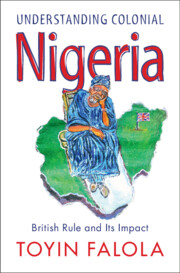Book contents
- Understanding Colonial Nigeria
- Understanding Colonial Nigeria
- Copyright page
- Dedication
- Contents
- Figures
- Maps
- Preface
- Acknowledgments
- Timeline of Events
- Part I Introduction
- Part II Conquest and Colonization
- Part III Colonial Societies
- 8 World War I and Its Aftermath
- 9 The Interwar Years
- 10 Indirect Rule and the Native Administration
- 11 The Legal System and Law Enforcement
- 12 Colonial Economy
- 13 Western Education
- 14 Social Changes
- 15 Women
- 16 Religions
- 17 Health and Medicine
- 18 Cultures
- 19 Urbanization
- 20 Creativity and Aesthetics
- Part IV Nationalism and Independence
- Part V Conclusion
- Bibliography
- Index
10 - Indirect Rule and the Native Administration
from Part III - Colonial Societies
Published online by Cambridge University Press: 21 November 2024
- Understanding Colonial Nigeria
- Understanding Colonial Nigeria
- Copyright page
- Dedication
- Contents
- Figures
- Maps
- Preface
- Acknowledgments
- Timeline of Events
- Part I Introduction
- Part II Conquest and Colonization
- Part III Colonial Societies
- 8 World War I and Its Aftermath
- 9 The Interwar Years
- 10 Indirect Rule and the Native Administration
- 11 The Legal System and Law Enforcement
- 12 Colonial Economy
- 13 Western Education
- 14 Social Changes
- 15 Women
- 16 Religions
- 17 Health and Medicine
- 18 Cultures
- 19 Urbanization
- 20 Creativity and Aesthetics
- Part IV Nationalism and Independence
- Part V Conclusion
- Bibliography
- Index
Summary
This chapter explores how Britain’s indirect rule policy was adapted to suit the preference of the colonial administrators and the specific circumstances of different Nigerian societies. It argues that the reasons that account for this adaptation were because Indigenous Nigerians had solid precolonial administrative and governance systems. When the British attempted to implement radical changes, they encountered massive resistance from the local people, resulting in an attempt to solve what the British described as the “Native Question.” It further discusses how Lord Lugard proposed an indirect rule system developed from the principle of the Dual Mandate as a response to the Native Question. However, it recognizes that the indirect rule system was not unique to the British, but was also implemented elsewhere by the Portuguese in Mozambique, the French in Tunisia and Algeria, and the Belgians in Rwanda and Burundi. By implementing the indirect rule system, Britain sought to forge cooperation between the native administration and colonial government. It further traces the history of native administration which back dates to 9000 BC and demonstrates the complexities of the precolonial states (such as the Oyo Empire and Sokoto Caliphate), and their centralized and decentralized administrative systems.
Keywords
- Type
- Chapter
- Information
- Understanding Colonial NigeriaBritish Rule and Its Impact, pp. 215 - 234Publisher: Cambridge University PressPrint publication year: 2024

